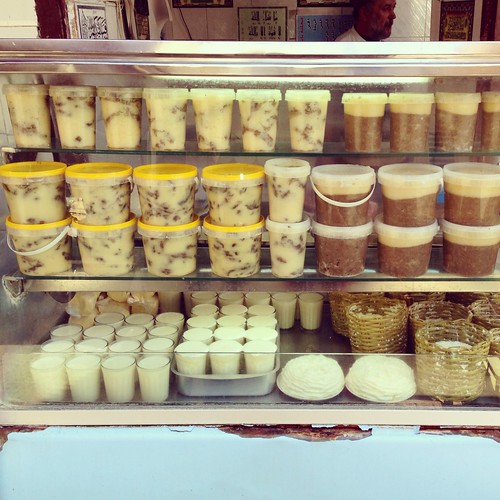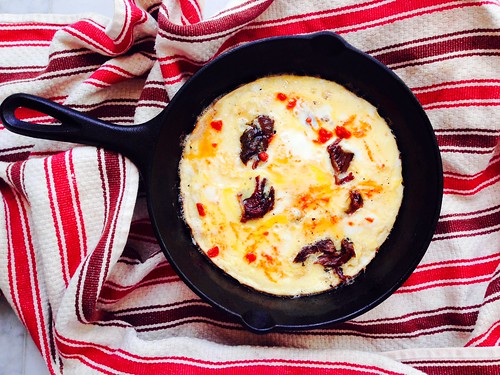
Today's local ingredient spotlight isn't exactly local, in the sense that it is hard to find where I live in Algiers. But it is very common in Morocco and in western Algeria, and I have a stash of it in my fridge that I carefully carried home from Marrakech.
The spotlight is khlea, which is essentially lamb (or beef) confit. A friend of mine noted that she had heard khlea (also pronounced khlii) described as "lamb tail preserved in sheep tallow fat" which has got to be the worst description of a food ever. It's not a terribly accurate description either, and in the sense that duck confit is simply duck rendered down and preserved in it's own fat, khlea is essentially lamb confit.
There are a few key differences that I should note though. The process of making khlea is to first cut your meat into strips or chunks, and then to coat it in salt and spices and let it age slightly. If you let the lamb dry out completely in this stage it is called qadid, and is basically jerky. To make the khlea, after the lamb/spice mixture has dried for a day or so, it is then slowly cooked in a mixture of fat and oil and then allowed to cool and solidify. The resulting mixture can then be kept for up to two years.
Obviously the practices for making khlea can vary widely depending on whether beef or lamb is used, how long it's dried, what spices are added, and the quality of the fat and oil it is preserved in. In Morocco you will see khlea piled in huge piles in the stands, or sold in jars, usually alongside a kind of fermented butter called smen.
(Note: In the photo above you see khlea, both the chunks and then the tiny bits of meat that are scooped out of the bottom of the pan. I prefer the chunks, but the bits are cheaper. Also pictured is yogurt and the local ijben cheese, which we talked about before here.)
If you are looking to buy khlea, definitely ask a local which stand he prefers, or find the one that has a really long line of locals in the morning. Often people stop and buy a tiny portion of khlea in the souq, and then take their tiny portion of khlea to a guy who will make them an omelet. Or they may take their tiny portion of khlea to a bakery in the souq, and have the baker warm up the khlea tucked inside a freshly baked piece of bread.
Khlea is immensely flavorful, and can also be used in stews, but in true North African fashion, it is best enjoyed with eggs. (North Africa has got to be the egg-eating capital of the world.) If you can get your hands on some khlea, this would be the first thing I'd make with it.

Tagine Khlea
I make this in a cast iron skillet because I don't have the more traditional small clay pan (one that looks like the bottom if a small tagine dish.) The word tagine can refer to any kind of pan, which is why this dish is traditionally called "tagine khlea."
4 eggs
5-6 pieces of khlea
salt
harissa or hot sauce of choice
optional: chopped herbs, tomatoes
1. Take your khlea out of the jar. If the pieces are very large then you can cut them with scissors. There will still be some fat clinging to the khlea, but you can rub off any of the really large chunks of fat. (Don't rinse it or anything!! The fat has lots of flavor.)
2. Heat up a small cast iron skillet and add the khlea over medium heat. Allow the fat to melt and the khlea to heat up and crisp a little bit.
3. Meanwhile, crack your eggs into a bowl and season with salt and a pinch of harissa. Beat the eggs with a fork. Add herbs and tomatoes if using.
4. Pour the eggs into the skillet and lower the heat to low. Partially cover the pan and allow the egg to cook until just set. Do not overcook them!! Serve immediately with more harissa and some warm bread.

it seems very delicious
ReplyDelete